Tesco: Key HRM and Marketing Functions and Organizational Structure
VerifiedAdded on 2020/12/09
|14
|3352
|478
Report
AI Summary
This report provides an in-depth analysis of Tesco's Human Resource Management (HRM) and Marketing functions, exploring their roles in promoting the organization's image and contributing to its success. The report examines key HRM functions such as training and development, recruitment and selection, talent management, performance and reward management, HR planning, and advisory functions, highlighting their impact on employee engagement and organizational goals. It also details marketing functions, including product management, distribution channels, financing, transportation and storage, selling, and promoting, emphasizing their role in creating brand image and meeting customer needs. Furthermore, the report discusses the impact of Tesco's effective organizational structure, particularly its tall hierarchical structure, on its overall performance, efficiency, and expansion. The analysis includes relevant figures and examples to illustrate the practical application of these concepts within Tesco's operations.
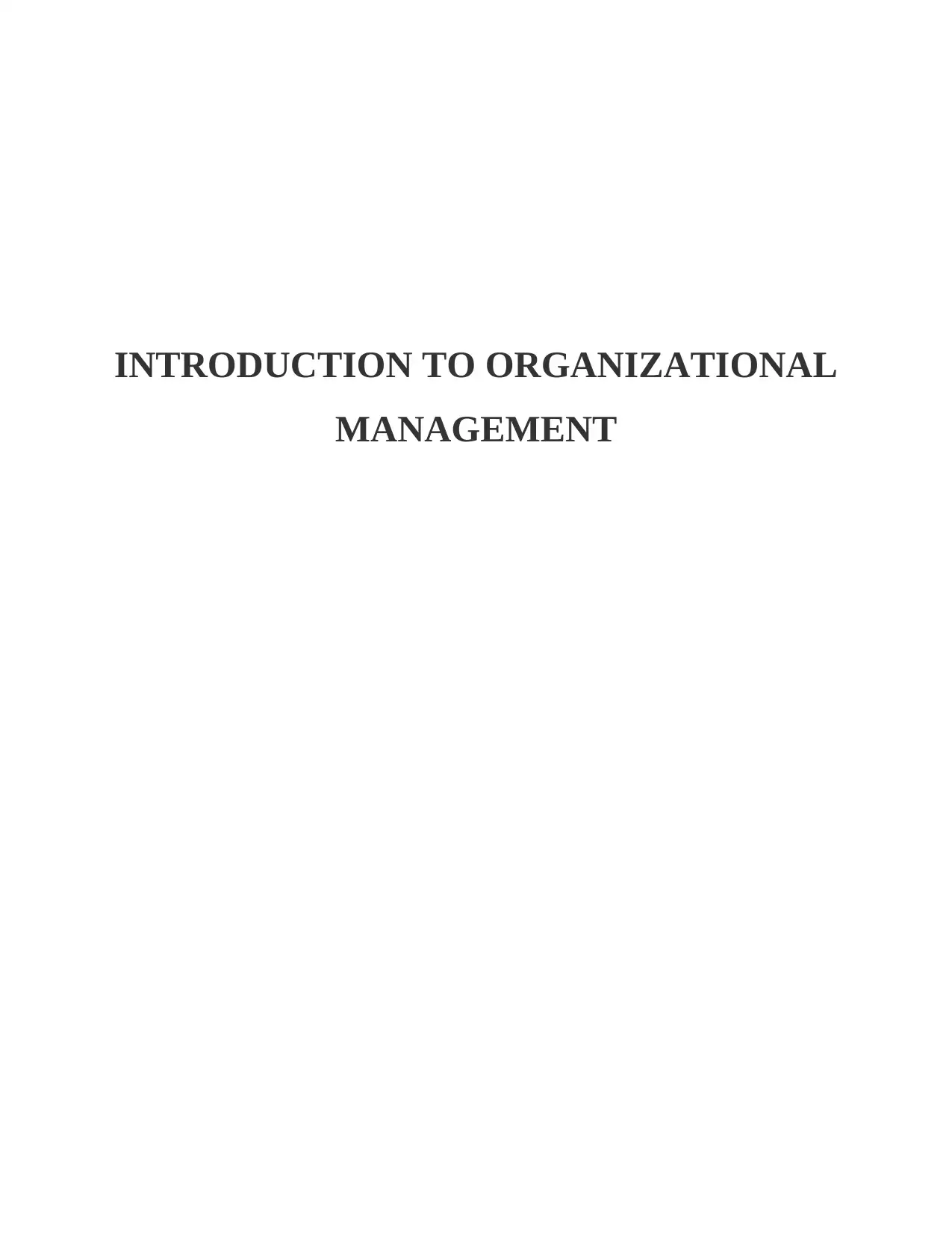
INTRODUCTION TO ORGANIZATIONAL
MANAGEMENT
MANAGEMENT
Paraphrase This Document
Need a fresh take? Get an instant paraphrase of this document with our AI Paraphraser
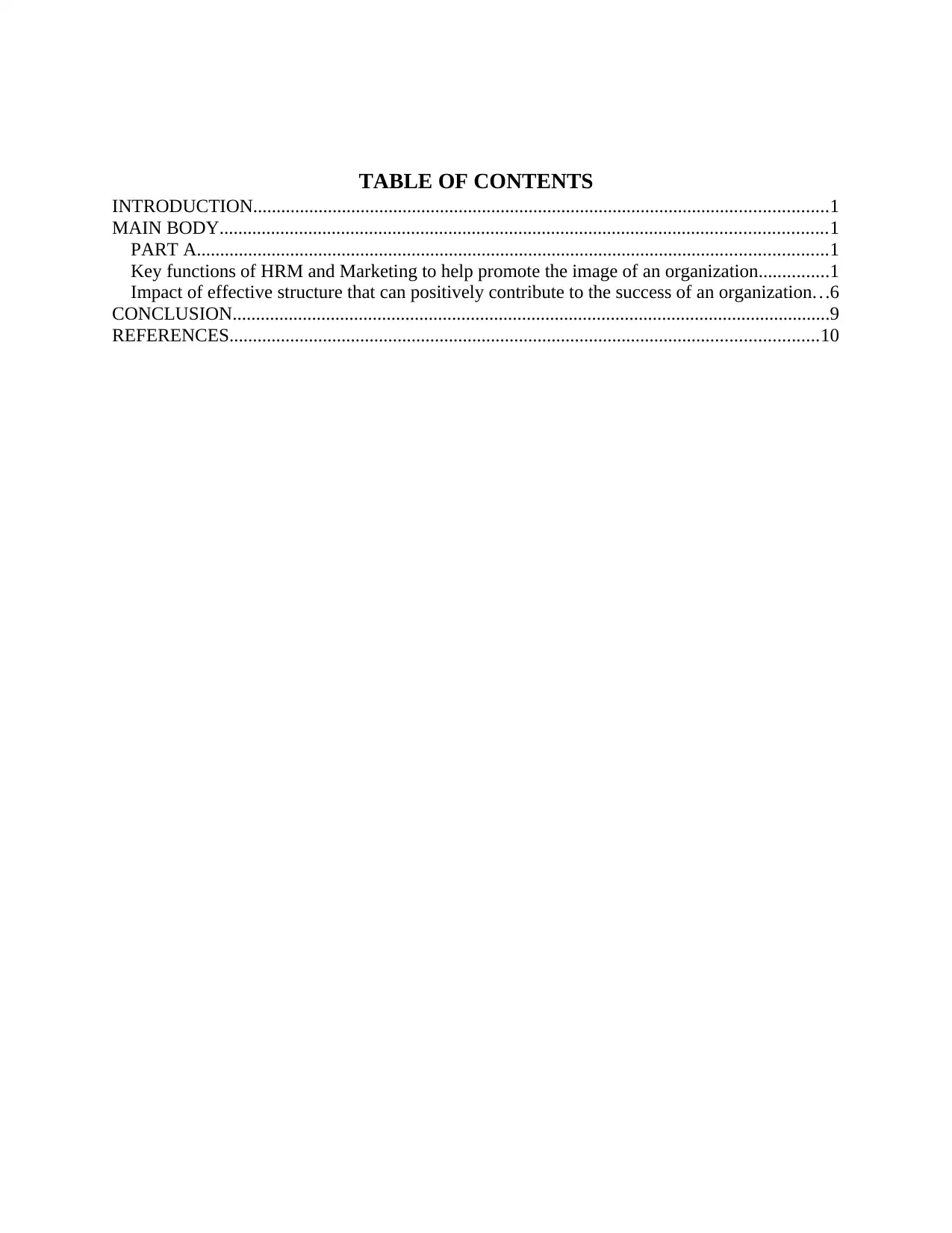
TABLE OF CONTENTS
INTRODUCTION...........................................................................................................................1
MAIN BODY..................................................................................................................................1
PART A.......................................................................................................................................1
Key functions of HRM and Marketing to help promote the image of an organization...............1
Impact of effective structure that can positively contribute to the success of an organization...6
CONCLUSION................................................................................................................................9
REFERENCES..............................................................................................................................10
INTRODUCTION...........................................................................................................................1
MAIN BODY..................................................................................................................................1
PART A.......................................................................................................................................1
Key functions of HRM and Marketing to help promote the image of an organization...............1
Impact of effective structure that can positively contribute to the success of an organization...6
CONCLUSION................................................................................................................................9
REFERENCES..............................................................................................................................10
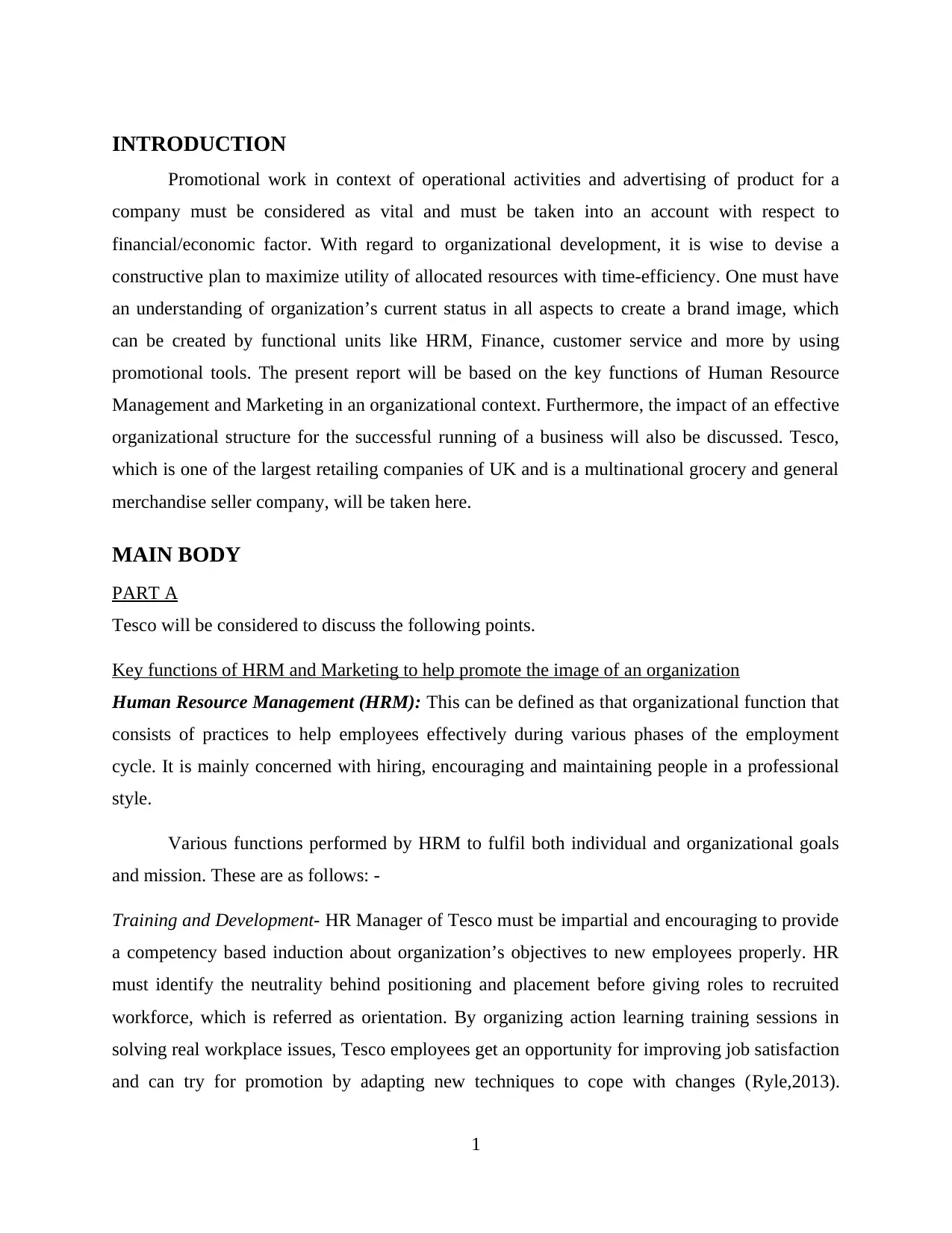
INTRODUCTION
Promotional work in context of operational activities and advertising of product for a
company must be considered as vital and must be taken into an account with respect to
financial/economic factor. With regard to organizational development, it is wise to devise a
constructive plan to maximize utility of allocated resources with time-efficiency. One must have
an understanding of organization’s current status in all aspects to create a brand image, which
can be created by functional units like HRM, Finance, customer service and more by using
promotional tools. The present report will be based on the key functions of Human Resource
Management and Marketing in an organizational context. Furthermore, the impact of an effective
organizational structure for the successful running of a business will also be discussed. Tesco,
which is one of the largest retailing companies of UK and is a multinational grocery and general
merchandise seller company, will be taken here.
MAIN BODY
PART A
Tesco will be considered to discuss the following points.
Key functions of HRM and Marketing to help promote the image of an organization
Human Resource Management (HRM): This can be defined as that organizational function that
consists of practices to help employees effectively during various phases of the employment
cycle. It is mainly concerned with hiring, encouraging and maintaining people in a professional
style.
Various functions performed by HRM to fulfil both individual and organizational goals
and mission. These are as follows: -
Training and Development- HR Manager of Tesco must be impartial and encouraging to provide
a competency based induction about organization’s objectives to new employees properly. HR
must identify the neutrality behind positioning and placement before giving roles to recruited
workforce, which is referred as orientation. By organizing action learning training sessions in
solving real workplace issues, Tesco employees get an opportunity for improving job satisfaction
and can try for promotion by adapting new techniques to cope with changes (Ryle,2013).
1
Promotional work in context of operational activities and advertising of product for a
company must be considered as vital and must be taken into an account with respect to
financial/economic factor. With regard to organizational development, it is wise to devise a
constructive plan to maximize utility of allocated resources with time-efficiency. One must have
an understanding of organization’s current status in all aspects to create a brand image, which
can be created by functional units like HRM, Finance, customer service and more by using
promotional tools. The present report will be based on the key functions of Human Resource
Management and Marketing in an organizational context. Furthermore, the impact of an effective
organizational structure for the successful running of a business will also be discussed. Tesco,
which is one of the largest retailing companies of UK and is a multinational grocery and general
merchandise seller company, will be taken here.
MAIN BODY
PART A
Tesco will be considered to discuss the following points.
Key functions of HRM and Marketing to help promote the image of an organization
Human Resource Management (HRM): This can be defined as that organizational function that
consists of practices to help employees effectively during various phases of the employment
cycle. It is mainly concerned with hiring, encouraging and maintaining people in a professional
style.
Various functions performed by HRM to fulfil both individual and organizational goals
and mission. These are as follows: -
Training and Development- HR Manager of Tesco must be impartial and encouraging to provide
a competency based induction about organization’s objectives to new employees properly. HR
must identify the neutrality behind positioning and placement before giving roles to recruited
workforce, which is referred as orientation. By organizing action learning training sessions in
solving real workplace issues, Tesco employees get an opportunity for improving job satisfaction
and can try for promotion by adapting new techniques to cope with changes (Ryle,2013).
1
⊘ This is a preview!⊘
Do you want full access?
Subscribe today to unlock all pages.

Trusted by 1+ million students worldwide
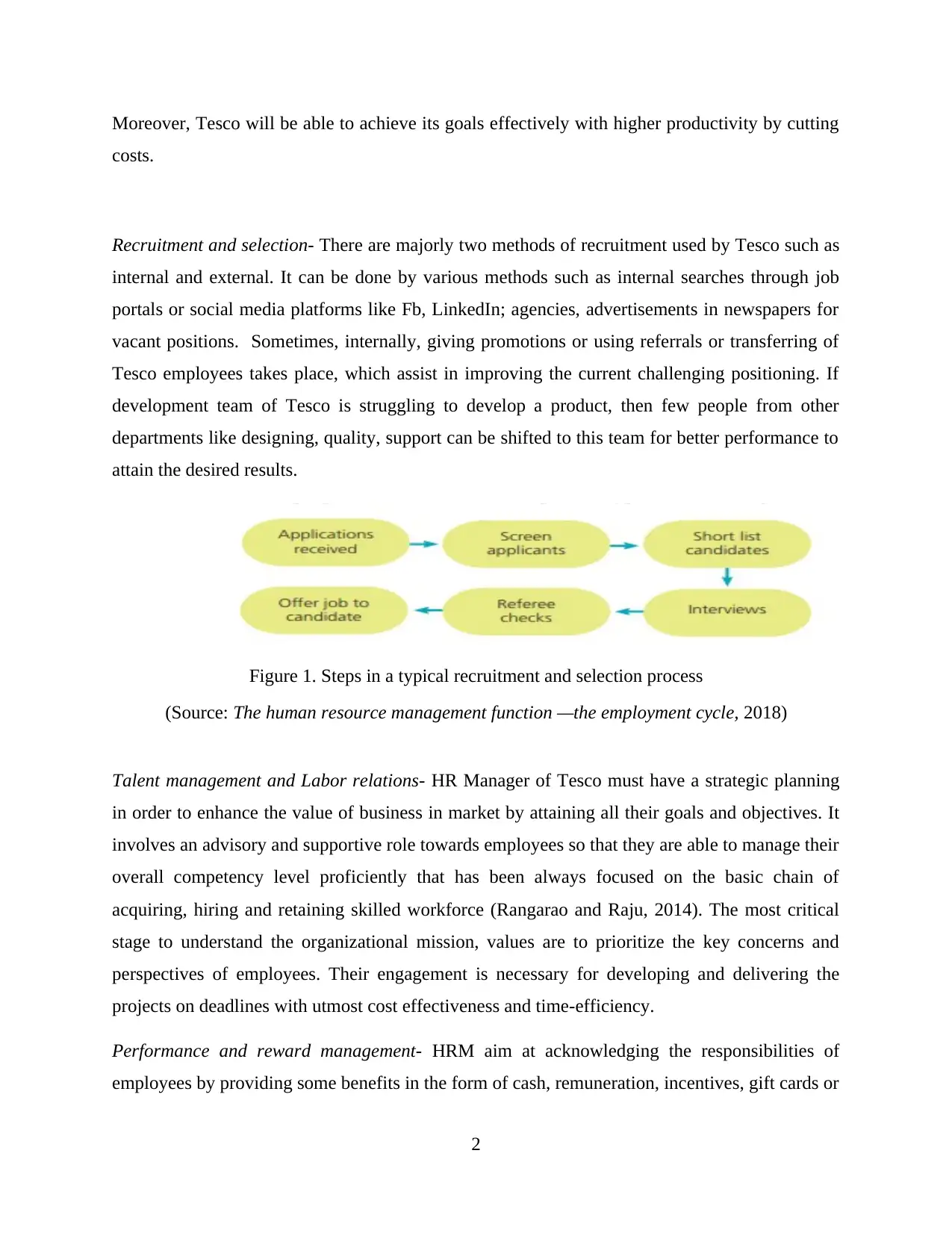
Moreover, Tesco will be able to achieve its goals effectively with higher productivity by cutting
costs.
Recruitment and selection- There are majorly two methods of recruitment used by Tesco such as
internal and external. It can be done by various methods such as internal searches through job
portals or social media platforms like Fb, LinkedIn; agencies, advertisements in newspapers for
vacant positions. Sometimes, internally, giving promotions or using referrals or transferring of
Tesco employees takes place, which assist in improving the current challenging positioning. If
development team of Tesco is struggling to develop a product, then few people from other
departments like designing, quality, support can be shifted to this team for better performance to
attain the desired results.
Figure 1. Steps in a typical recruitment and selection process
(Source: The human resource management function —the employment cycle, 2018)
Talent management and Labor relations- HR Manager of Tesco must have a strategic planning
in order to enhance the value of business in market by attaining all their goals and objectives. It
involves an advisory and supportive role towards employees so that they are able to manage their
overall competency level proficiently that has been always focused on the basic chain of
acquiring, hiring and retaining skilled workforce (Rangarao and Raju, 2014). The most critical
stage to understand the organizational mission, values are to prioritize the key concerns and
perspectives of employees. Their engagement is necessary for developing and delivering the
projects on deadlines with utmost cost effectiveness and time-efficiency.
Performance and reward management- HRM aim at acknowledging the responsibilities of
employees by providing some benefits in the form of cash, remuneration, incentives, gift cards or
2
costs.
Recruitment and selection- There are majorly two methods of recruitment used by Tesco such as
internal and external. It can be done by various methods such as internal searches through job
portals or social media platforms like Fb, LinkedIn; agencies, advertisements in newspapers for
vacant positions. Sometimes, internally, giving promotions or using referrals or transferring of
Tesco employees takes place, which assist in improving the current challenging positioning. If
development team of Tesco is struggling to develop a product, then few people from other
departments like designing, quality, support can be shifted to this team for better performance to
attain the desired results.
Figure 1. Steps in a typical recruitment and selection process
(Source: The human resource management function —the employment cycle, 2018)
Talent management and Labor relations- HR Manager of Tesco must have a strategic planning
in order to enhance the value of business in market by attaining all their goals and objectives. It
involves an advisory and supportive role towards employees so that they are able to manage their
overall competency level proficiently that has been always focused on the basic chain of
acquiring, hiring and retaining skilled workforce (Rangarao and Raju, 2014). The most critical
stage to understand the organizational mission, values are to prioritize the key concerns and
perspectives of employees. Their engagement is necessary for developing and delivering the
projects on deadlines with utmost cost effectiveness and time-efficiency.
Performance and reward management- HRM aim at acknowledging the responsibilities of
employees by providing some benefits in the form of cash, remuneration, incentives, gift cards or
2
Paraphrase This Document
Need a fresh take? Get an instant paraphrase of this document with our AI Paraphraser
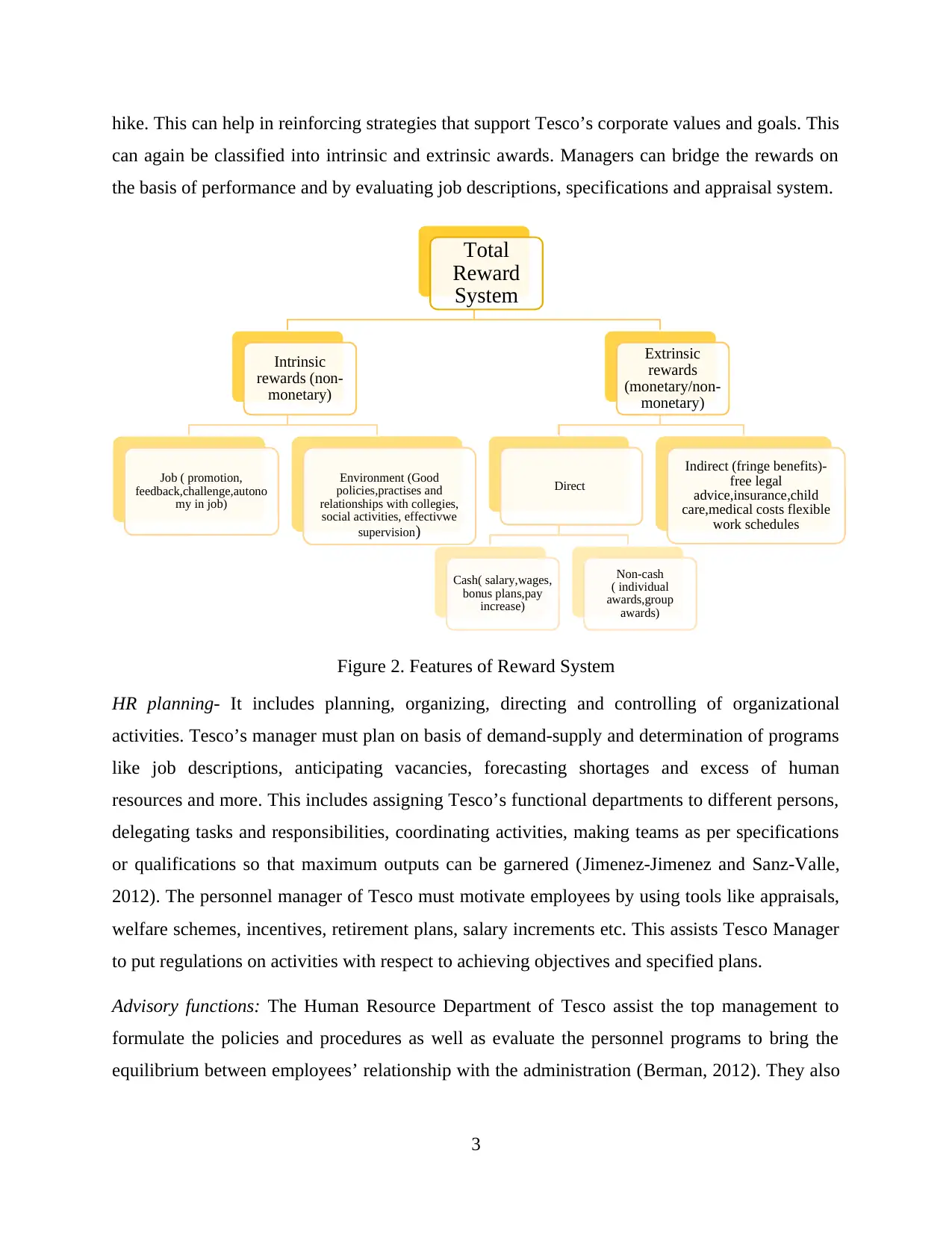
hike. This can help in reinforcing strategies that support Tesco’s corporate values and goals. This
can again be classified into intrinsic and extrinsic awards. Managers can bridge the rewards on
the basis of performance and by evaluating job descriptions, specifications and appraisal system.
Figure 2. Features of Reward System
HR planning- It includes planning, organizing, directing and controlling of organizational
activities. Tesco’s manager must plan on basis of demand-supply and determination of programs
like job descriptions, anticipating vacancies, forecasting shortages and excess of human
resources and more. This includes assigning Tesco’s functional departments to different persons,
delegating tasks and responsibilities, coordinating activities, making teams as per specifications
or qualifications so that maximum outputs can be garnered (Jimenez-Jimenez and Sanz-Valle,
2012). The personnel manager of Tesco must motivate employees by using tools like appraisals,
welfare schemes, incentives, retirement plans, salary increments etc. This assists Tesco Manager
to put regulations on activities with respect to achieving objectives and specified plans.
Advisory functions: The Human Resource Department of Tesco assist the top management to
formulate the policies and procedures as well as evaluate the personnel programs to bring the
equilibrium between employees’ relationship with the administration (Berman, 2012). They also
3
Total
Reward
System
Intrinsic
rewards (non-
monetary)
Job ( promotion,
feedback,challenge,autono
my in job)
Environment (Good
policies,practises and
relationships with collegies,
social activities, effectivwe
supervision )
Extrinsic
rewards
(monetary/non-
monetary)
Direct
Cash( salary,wages,
bonus plans,pay
increase)
Non-cash
( individual
awards,group
awards)
Indirect (fringe benefits)-
free legal
advice,insurance,child
care,medical costs flexible
work schedules
can again be classified into intrinsic and extrinsic awards. Managers can bridge the rewards on
the basis of performance and by evaluating job descriptions, specifications and appraisal system.
Figure 2. Features of Reward System
HR planning- It includes planning, organizing, directing and controlling of organizational
activities. Tesco’s manager must plan on basis of demand-supply and determination of programs
like job descriptions, anticipating vacancies, forecasting shortages and excess of human
resources and more. This includes assigning Tesco’s functional departments to different persons,
delegating tasks and responsibilities, coordinating activities, making teams as per specifications
or qualifications so that maximum outputs can be garnered (Jimenez-Jimenez and Sanz-Valle,
2012). The personnel manager of Tesco must motivate employees by using tools like appraisals,
welfare schemes, incentives, retirement plans, salary increments etc. This assists Tesco Manager
to put regulations on activities with respect to achieving objectives and specified plans.
Advisory functions: The Human Resource Department of Tesco assist the top management to
formulate the policies and procedures as well as evaluate the personnel programs to bring the
equilibrium between employees’ relationship with the administration (Berman, 2012). They also
3
Total
Reward
System
Intrinsic
rewards (non-
monetary)
Job ( promotion,
feedback,challenge,autono
my in job)
Environment (Good
policies,practises and
relationships with collegies,
social activities, effectivwe
supervision )
Extrinsic
rewards
(monetary/non-
monetary)
Direct
Cash( salary,wages,
bonus plans,pay
increase)
Non-cash
( individual
awards,group
awards)
Indirect (fringe benefits)-
free legal
advice,insurance,child
care,medical costs flexible
work schedules
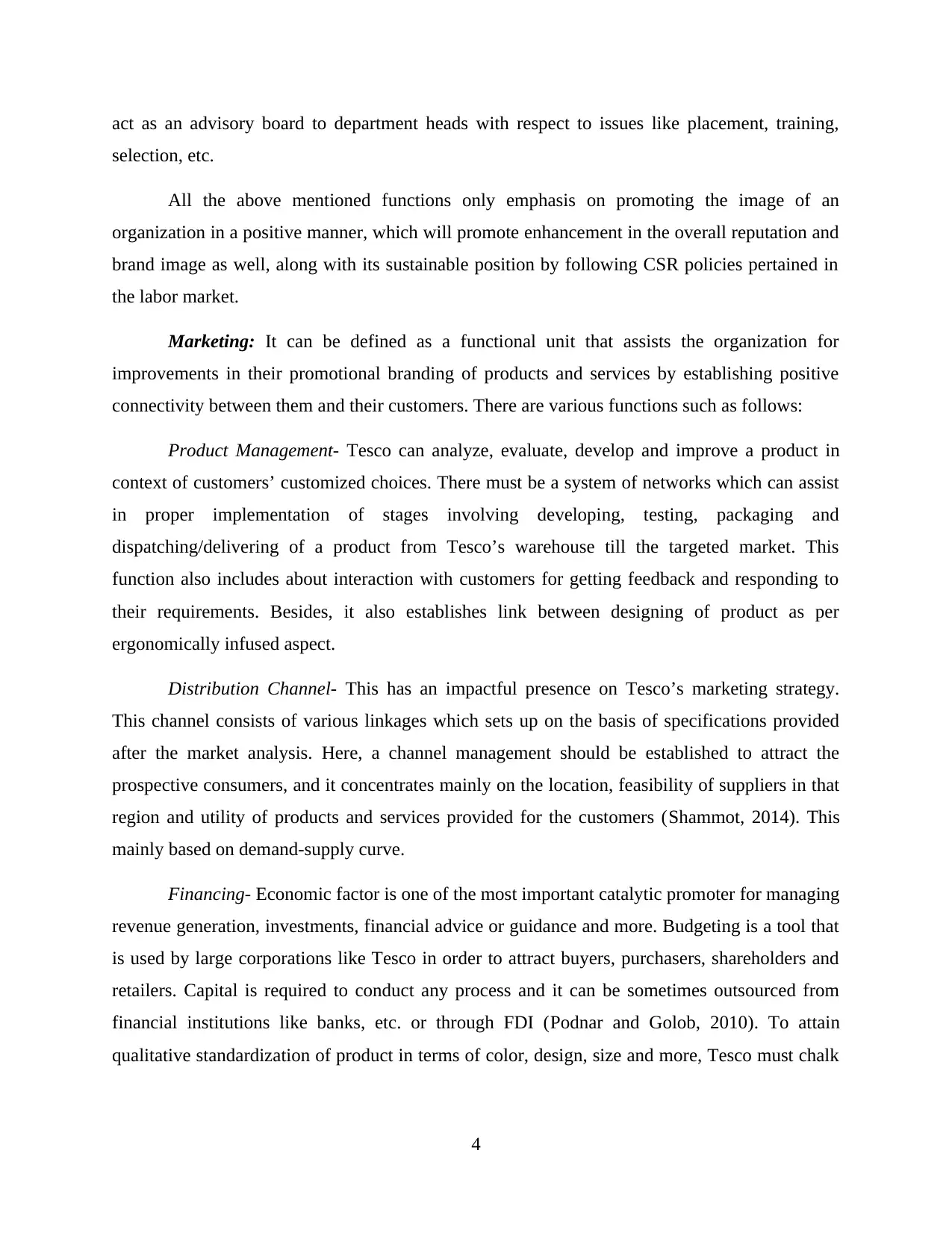
act as an advisory board to department heads with respect to issues like placement, training,
selection, etc.
All the above mentioned functions only emphasis on promoting the image of an
organization in a positive manner, which will promote enhancement in the overall reputation and
brand image as well, along with its sustainable position by following CSR policies pertained in
the labor market.
Marketing: It can be defined as a functional unit that assists the organization for
improvements in their promotional branding of products and services by establishing positive
connectivity between them and their customers. There are various functions such as follows:
Product Management- Tesco can analyze, evaluate, develop and improve a product in
context of customers’ customized choices. There must be a system of networks which can assist
in proper implementation of stages involving developing, testing, packaging and
dispatching/delivering of a product from Tesco’s warehouse till the targeted market. This
function also includes about interaction with customers for getting feedback and responding to
their requirements. Besides, it also establishes link between designing of product as per
ergonomically infused aspect.
Distribution Channel- This has an impactful presence on Tesco’s marketing strategy.
This channel consists of various linkages which sets up on the basis of specifications provided
after the market analysis. Here, a channel management should be established to attract the
prospective consumers, and it concentrates mainly on the location, feasibility of suppliers in that
region and utility of products and services provided for the customers (Shammot, 2014). This
mainly based on demand-supply curve.
Financing- Economic factor is one of the most important catalytic promoter for managing
revenue generation, investments, financial advice or guidance and more. Budgeting is a tool that
is used by large corporations like Tesco in order to attract buyers, purchasers, shareholders and
retailers. Capital is required to conduct any process and it can be sometimes outsourced from
financial institutions like banks, etc. or through FDI (Podnar and Golob, 2010). To attain
qualitative standardization of product in terms of color, design, size and more, Tesco must chalk
4
selection, etc.
All the above mentioned functions only emphasis on promoting the image of an
organization in a positive manner, which will promote enhancement in the overall reputation and
brand image as well, along with its sustainable position by following CSR policies pertained in
the labor market.
Marketing: It can be defined as a functional unit that assists the organization for
improvements in their promotional branding of products and services by establishing positive
connectivity between them and their customers. There are various functions such as follows:
Product Management- Tesco can analyze, evaluate, develop and improve a product in
context of customers’ customized choices. There must be a system of networks which can assist
in proper implementation of stages involving developing, testing, packaging and
dispatching/delivering of a product from Tesco’s warehouse till the targeted market. This
function also includes about interaction with customers for getting feedback and responding to
their requirements. Besides, it also establishes link between designing of product as per
ergonomically infused aspect.
Distribution Channel- This has an impactful presence on Tesco’s marketing strategy.
This channel consists of various linkages which sets up on the basis of specifications provided
after the market analysis. Here, a channel management should be established to attract the
prospective consumers, and it concentrates mainly on the location, feasibility of suppliers in that
region and utility of products and services provided for the customers (Shammot, 2014). This
mainly based on demand-supply curve.
Financing- Economic factor is one of the most important catalytic promoter for managing
revenue generation, investments, financial advice or guidance and more. Budgeting is a tool that
is used by large corporations like Tesco in order to attract buyers, purchasers, shareholders and
retailers. Capital is required to conduct any process and it can be sometimes outsourced from
financial institutions like banks, etc. or through FDI (Podnar and Golob, 2010). To attain
qualitative standardization of product in terms of color, design, size and more, Tesco must chalk
4
⊘ This is a preview!⊘
Do you want full access?
Subscribe today to unlock all pages.

Trusted by 1+ million students worldwide

out a strategy to attract potential finances which can be based on optimum utilization of
resources.
Transportation and storage- There are various means of transportation such as road,
airlines and sea, which can help Tesco in delivering their products to retailers or buyers on time.
Here, utility of a location can be the indicator of a business success in terms of economic scale of
development. Storage is defined as that function which protects and prevent the product to get
deteriorated. It manages the physical movement of product by keeping the quality intact and
viable to use in future. For example, warehouses, shops, inventory etc.
Selling- This concept is applied for exploring and measuring the market based on
customer’s needs and requirements. It is focused on the product only by the use of promotional
campaigns (Mollah, 2014). This is mainly positioned on the sales and works on the cycle of
generating products into cash. Additionally, it lies on the vendor’s viewpoint to fetch profit that
enhances the overall success rate as well as growth of Tesco at global level.
Promoting- With emergence of social media podiums on internet and impact of
globalization, Tesco can easily promote its products and services effortlessly. They can use
traditional methods like bill boards, TV, radio and more. However, these are expensive and time
consuming techniques. Its sustainability rate is low as compared to digitalized tools as there is
very little interaction between public and organization (Felgate and Fearne, 2015). On the other
hand, internet has boosted sales and revenue generation at the local as well as international scale.
It is cost efficient technique and can be simultaneously implemented on various platforms like
Facebook, YouTube, twitter or opening their website. Along with this, data and results are
measurable.
Marketing and its functions are useful in creating a brand image by engaging on the
needs and wants of consumers. Subsequently, as time is passing with advanced technology
developments, there is a need for strategic planning for product development by creating its
awareness effectively as the prime focus is to satisfy the customers.
5
resources.
Transportation and storage- There are various means of transportation such as road,
airlines and sea, which can help Tesco in delivering their products to retailers or buyers on time.
Here, utility of a location can be the indicator of a business success in terms of economic scale of
development. Storage is defined as that function which protects and prevent the product to get
deteriorated. It manages the physical movement of product by keeping the quality intact and
viable to use in future. For example, warehouses, shops, inventory etc.
Selling- This concept is applied for exploring and measuring the market based on
customer’s needs and requirements. It is focused on the product only by the use of promotional
campaigns (Mollah, 2014). This is mainly positioned on the sales and works on the cycle of
generating products into cash. Additionally, it lies on the vendor’s viewpoint to fetch profit that
enhances the overall success rate as well as growth of Tesco at global level.
Promoting- With emergence of social media podiums on internet and impact of
globalization, Tesco can easily promote its products and services effortlessly. They can use
traditional methods like bill boards, TV, radio and more. However, these are expensive and time
consuming techniques. Its sustainability rate is low as compared to digitalized tools as there is
very little interaction between public and organization (Felgate and Fearne, 2015). On the other
hand, internet has boosted sales and revenue generation at the local as well as international scale.
It is cost efficient technique and can be simultaneously implemented on various platforms like
Facebook, YouTube, twitter or opening their website. Along with this, data and results are
measurable.
Marketing and its functions are useful in creating a brand image by engaging on the
needs and wants of consumers. Subsequently, as time is passing with advanced technology
developments, there is a need for strategic planning for product development by creating its
awareness effectively as the prime focus is to satisfy the customers.
5
Paraphrase This Document
Need a fresh take? Get an instant paraphrase of this document with our AI Paraphraser
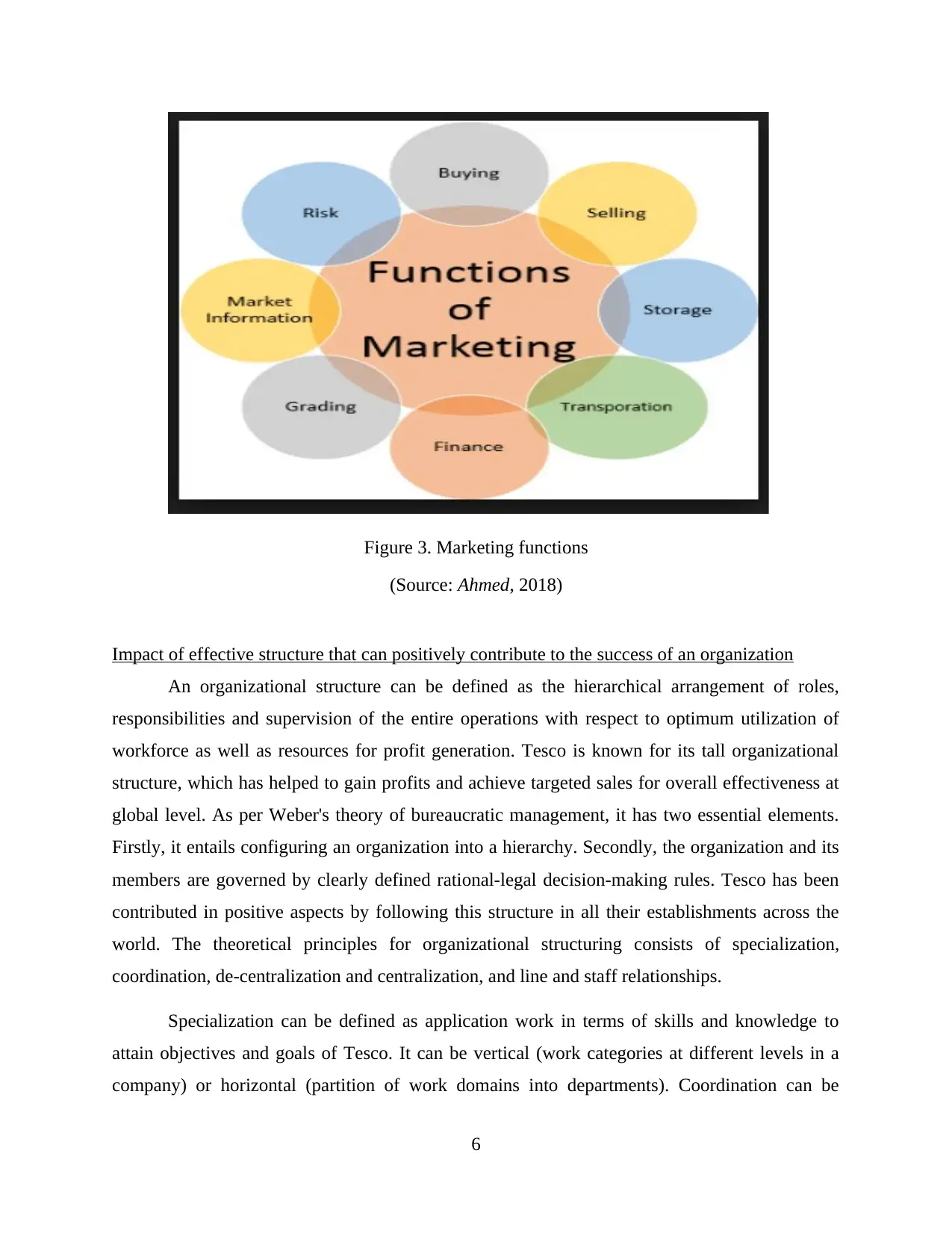
Figure 3. Marketing functions
(Source: Ahmed, 2018)
Impact of effective structure that can positively contribute to the success of an organization
An organizational structure can be defined as the hierarchical arrangement of roles,
responsibilities and supervision of the entire operations with respect to optimum utilization of
workforce as well as resources for profit generation. Tesco is known for its tall organizational
structure, which has helped to gain profits and achieve targeted sales for overall effectiveness at
global level. As per Weber's theory of bureaucratic management, it has two essential elements.
Firstly, it entails configuring an organization into a hierarchy. Secondly, the organization and its
members are governed by clearly defined rational-legal decision-making rules. Tesco has been
contributed in positive aspects by following this structure in all their establishments across the
world. The theoretical principles for organizational structuring consists of specialization,
coordination, de-centralization and centralization, and line and staff relationships.
Specialization can be defined as application work in terms of skills and knowledge to
attain objectives and goals of Tesco. It can be vertical (work categories at different levels in a
company) or horizontal (partition of work domains into departments). Coordination can be
6
(Source: Ahmed, 2018)
Impact of effective structure that can positively contribute to the success of an organization
An organizational structure can be defined as the hierarchical arrangement of roles,
responsibilities and supervision of the entire operations with respect to optimum utilization of
workforce as well as resources for profit generation. Tesco is known for its tall organizational
structure, which has helped to gain profits and achieve targeted sales for overall effectiveness at
global level. As per Weber's theory of bureaucratic management, it has two essential elements.
Firstly, it entails configuring an organization into a hierarchy. Secondly, the organization and its
members are governed by clearly defined rational-legal decision-making rules. Tesco has been
contributed in positive aspects by following this structure in all their establishments across the
world. The theoretical principles for organizational structuring consists of specialization,
coordination, de-centralization and centralization, and line and staff relationships.
Specialization can be defined as application work in terms of skills and knowledge to
attain objectives and goals of Tesco. It can be vertical (work categories at different levels in a
company) or horizontal (partition of work domains into departments). Coordination can be
6
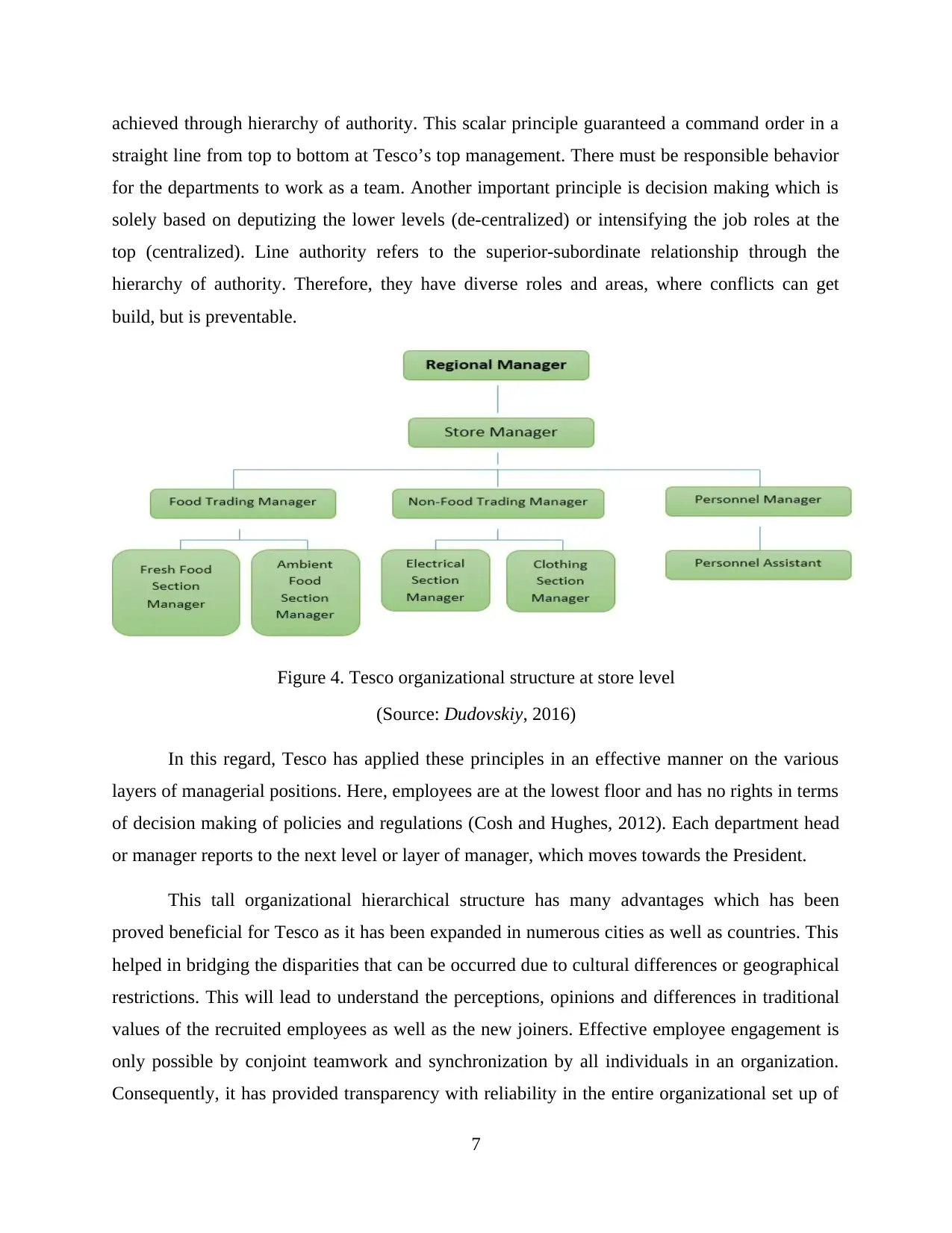
achieved through hierarchy of authority. This scalar principle guaranteed a command order in a
straight line from top to bottom at Tesco’s top management. There must be responsible behavior
for the departments to work as a team. Another important principle is decision making which is
solely based on deputizing the lower levels (de-centralized) or intensifying the job roles at the
top (centralized). Line authority refers to the superior-subordinate relationship through the
hierarchy of authority. Therefore, they have diverse roles and areas, where conflicts can get
build, but is preventable.
Figure 4. Tesco organizational structure at store level
(Source: Dudovskiy, 2016)
In this regard, Tesco has applied these principles in an effective manner on the various
layers of managerial positions. Here, employees are at the lowest floor and has no rights in terms
of decision making of policies and regulations (Cosh and Hughes, 2012). Each department head
or manager reports to the next level or layer of manager, which moves towards the President.
This tall organizational hierarchical structure has many advantages which has been
proved beneficial for Tesco as it has been expanded in numerous cities as well as countries. This
helped in bridging the disparities that can be occurred due to cultural differences or geographical
restrictions. This will lead to understand the perceptions, opinions and differences in traditional
values of the recruited employees as well as the new joiners. Effective employee engagement is
only possible by conjoint teamwork and synchronization by all individuals in an organization.
Consequently, it has provided transparency with reliability in the entire organizational set up of
7
straight line from top to bottom at Tesco’s top management. There must be responsible behavior
for the departments to work as a team. Another important principle is decision making which is
solely based on deputizing the lower levels (de-centralized) or intensifying the job roles at the
top (centralized). Line authority refers to the superior-subordinate relationship through the
hierarchy of authority. Therefore, they have diverse roles and areas, where conflicts can get
build, but is preventable.
Figure 4. Tesco organizational structure at store level
(Source: Dudovskiy, 2016)
In this regard, Tesco has applied these principles in an effective manner on the various
layers of managerial positions. Here, employees are at the lowest floor and has no rights in terms
of decision making of policies and regulations (Cosh and Hughes, 2012). Each department head
or manager reports to the next level or layer of manager, which moves towards the President.
This tall organizational hierarchical structure has many advantages which has been
proved beneficial for Tesco as it has been expanded in numerous cities as well as countries. This
helped in bridging the disparities that can be occurred due to cultural differences or geographical
restrictions. This will lead to understand the perceptions, opinions and differences in traditional
values of the recruited employees as well as the new joiners. Effective employee engagement is
only possible by conjoint teamwork and synchronization by all individuals in an organization.
Consequently, it has provided transparency with reliability in the entire organizational set up of
7
⊘ This is a preview!⊘
Do you want full access?
Subscribe today to unlock all pages.

Trusted by 1+ million students worldwide
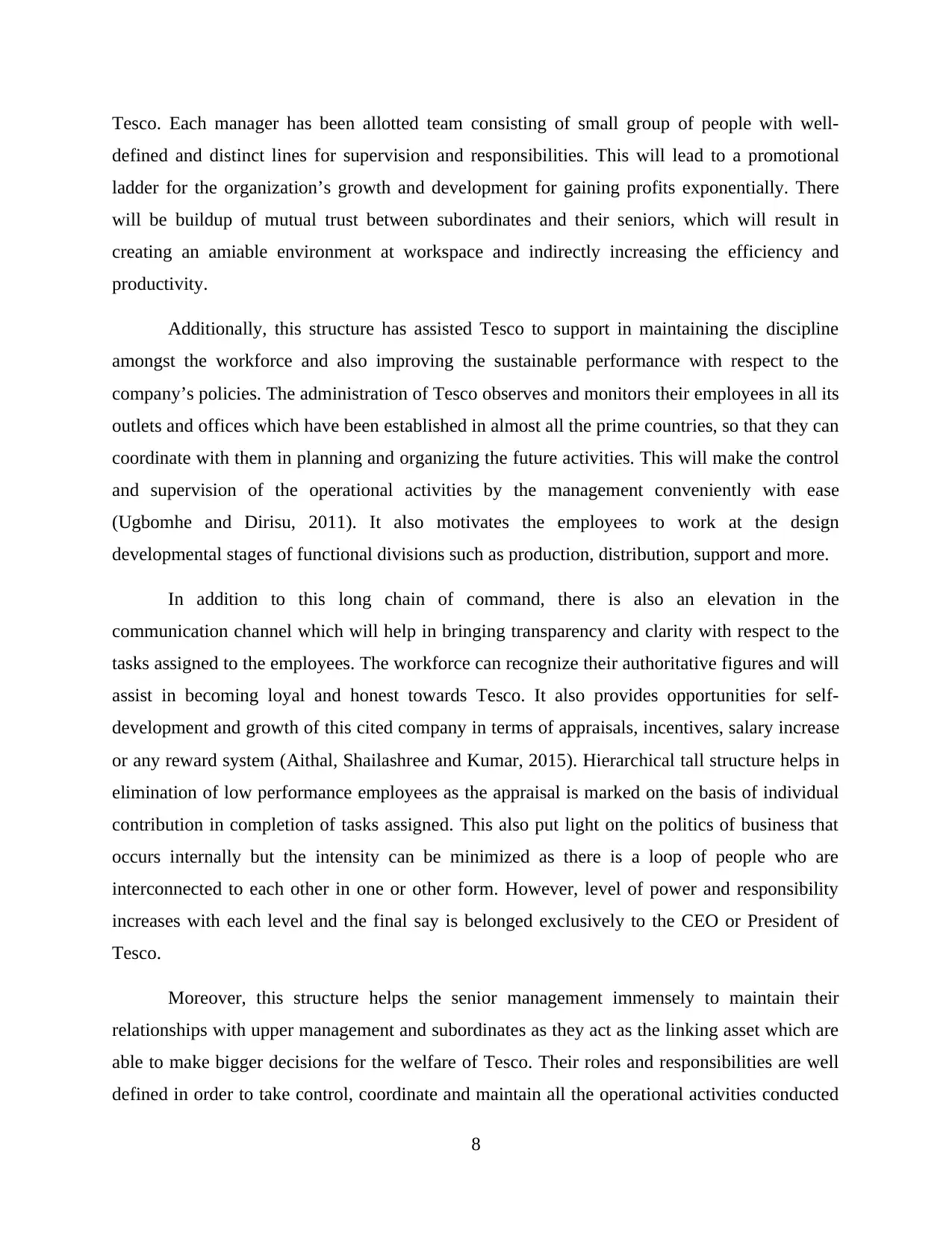
Tesco. Each manager has been allotted team consisting of small group of people with well-
defined and distinct lines for supervision and responsibilities. This will lead to a promotional
ladder for the organization’s growth and development for gaining profits exponentially. There
will be buildup of mutual trust between subordinates and their seniors, which will result in
creating an amiable environment at workspace and indirectly increasing the efficiency and
productivity.
Additionally, this structure has assisted Tesco to support in maintaining the discipline
amongst the workforce and also improving the sustainable performance with respect to the
company’s policies. The administration of Tesco observes and monitors their employees in all its
outlets and offices which have been established in almost all the prime countries, so that they can
coordinate with them in planning and organizing the future activities. This will make the control
and supervision of the operational activities by the management conveniently with ease
(Ugbomhe and Dirisu, 2011). It also motivates the employees to work at the design
developmental stages of functional divisions such as production, distribution, support and more.
In addition to this long chain of command, there is also an elevation in the
communication channel which will help in bringing transparency and clarity with respect to the
tasks assigned to the employees. The workforce can recognize their authoritative figures and will
assist in becoming loyal and honest towards Tesco. It also provides opportunities for self-
development and growth of this cited company in terms of appraisals, incentives, salary increase
or any reward system (Aithal, Shailashree and Kumar, 2015). Hierarchical tall structure helps in
elimination of low performance employees as the appraisal is marked on the basis of individual
contribution in completion of tasks assigned. This also put light on the politics of business that
occurs internally but the intensity can be minimized as there is a loop of people who are
interconnected to each other in one or other form. However, level of power and responsibility
increases with each level and the final say is belonged exclusively to the CEO or President of
Tesco.
Moreover, this structure helps the senior management immensely to maintain their
relationships with upper management and subordinates as they act as the linking asset which are
able to make bigger decisions for the welfare of Tesco. Their roles and responsibilities are well
defined in order to take control, coordinate and maintain all the operational activities conducted
8
defined and distinct lines for supervision and responsibilities. This will lead to a promotional
ladder for the organization’s growth and development for gaining profits exponentially. There
will be buildup of mutual trust between subordinates and their seniors, which will result in
creating an amiable environment at workspace and indirectly increasing the efficiency and
productivity.
Additionally, this structure has assisted Tesco to support in maintaining the discipline
amongst the workforce and also improving the sustainable performance with respect to the
company’s policies. The administration of Tesco observes and monitors their employees in all its
outlets and offices which have been established in almost all the prime countries, so that they can
coordinate with them in planning and organizing the future activities. This will make the control
and supervision of the operational activities by the management conveniently with ease
(Ugbomhe and Dirisu, 2011). It also motivates the employees to work at the design
developmental stages of functional divisions such as production, distribution, support and more.
In addition to this long chain of command, there is also an elevation in the
communication channel which will help in bringing transparency and clarity with respect to the
tasks assigned to the employees. The workforce can recognize their authoritative figures and will
assist in becoming loyal and honest towards Tesco. It also provides opportunities for self-
development and growth of this cited company in terms of appraisals, incentives, salary increase
or any reward system (Aithal, Shailashree and Kumar, 2015). Hierarchical tall structure helps in
elimination of low performance employees as the appraisal is marked on the basis of individual
contribution in completion of tasks assigned. This also put light on the politics of business that
occurs internally but the intensity can be minimized as there is a loop of people who are
interconnected to each other in one or other form. However, level of power and responsibility
increases with each level and the final say is belonged exclusively to the CEO or President of
Tesco.
Moreover, this structure helps the senior management immensely to maintain their
relationships with upper management and subordinates as they act as the linking asset which are
able to make bigger decisions for the welfare of Tesco. Their roles and responsibilities are well
defined in order to take control, coordinate and maintain all the operational activities conducted
8
Paraphrase This Document
Need a fresh take? Get an instant paraphrase of this document with our AI Paraphraser
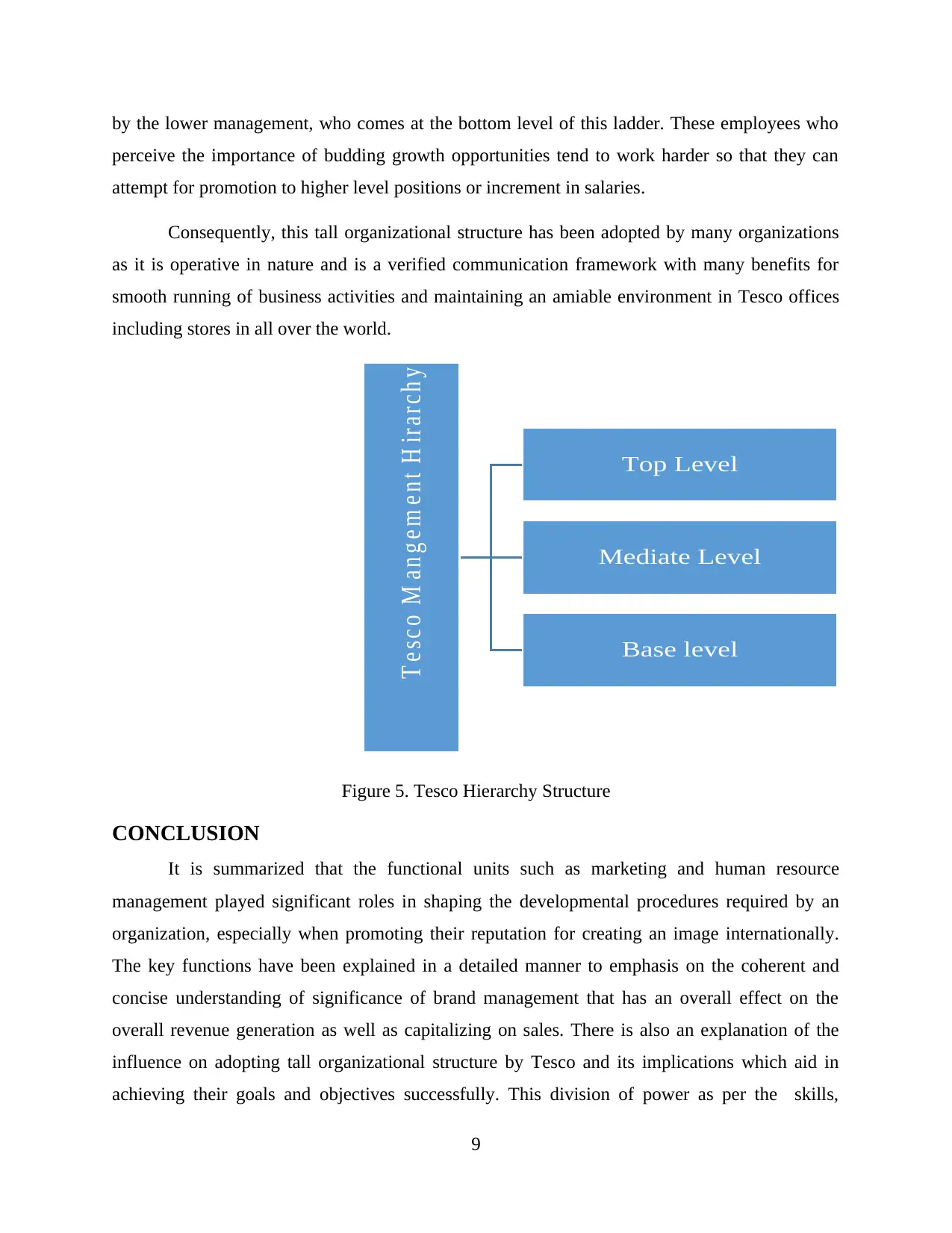
by the lower management, who comes at the bottom level of this ladder. These employees who
perceive the importance of budding growth opportunities tend to work harder so that they can
attempt for promotion to higher level positions or increment in salaries.
Consequently, this tall organizational structure has been adopted by many organizations
as it is operative in nature and is a verified communication framework with many benefits for
smooth running of business activities and maintaining an amiable environment in Tesco offices
including stores in all over the world.
Figure 5. Tesco Hierarchy Structure
CONCLUSION
It is summarized that the functional units such as marketing and human resource
management played significant roles in shaping the developmental procedures required by an
organization, especially when promoting their reputation for creating an image internationally.
The key functions have been explained in a detailed manner to emphasis on the coherent and
concise understanding of significance of brand management that has an overall effect on the
overall revenue generation as well as capitalizing on sales. There is also an explanation of the
influence on adopting tall organizational structure by Tesco and its implications which aid in
achieving their goals and objectives successfully. This division of power as per the skills,
9
T e s c o M a n g e m e n t H ir a rc h y
Top Level
Mediate Level
Base level
perceive the importance of budding growth opportunities tend to work harder so that they can
attempt for promotion to higher level positions or increment in salaries.
Consequently, this tall organizational structure has been adopted by many organizations
as it is operative in nature and is a verified communication framework with many benefits for
smooth running of business activities and maintaining an amiable environment in Tesco offices
including stores in all over the world.
Figure 5. Tesco Hierarchy Structure
CONCLUSION
It is summarized that the functional units such as marketing and human resource
management played significant roles in shaping the developmental procedures required by an
organization, especially when promoting their reputation for creating an image internationally.
The key functions have been explained in a detailed manner to emphasis on the coherent and
concise understanding of significance of brand management that has an overall effect on the
overall revenue generation as well as capitalizing on sales. There is also an explanation of the
influence on adopting tall organizational structure by Tesco and its implications which aid in
achieving their goals and objectives successfully. This division of power as per the skills,
9
T e s c o M a n g e m e n t H ir a rc h y
Top Level
Mediate Level
Base level
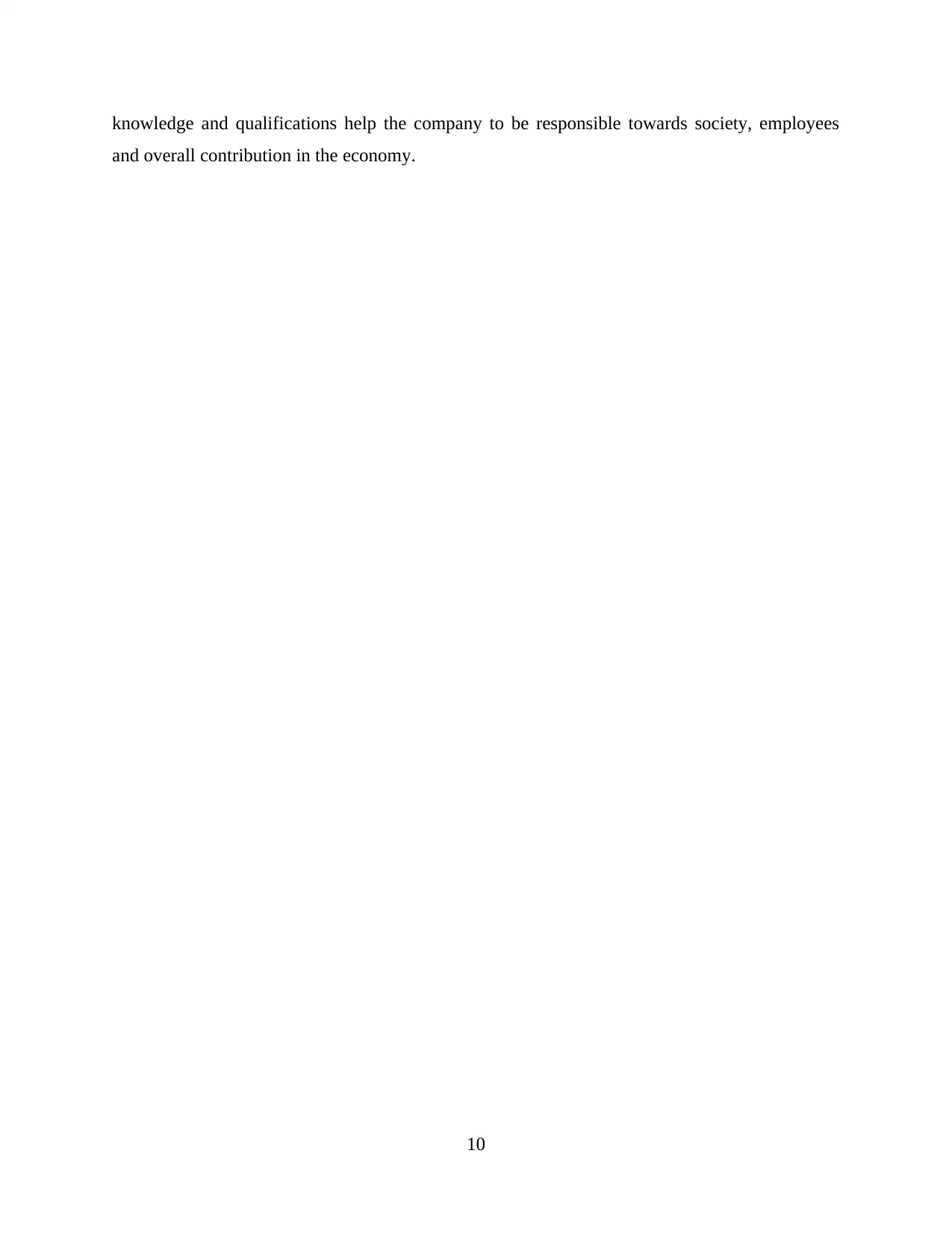
knowledge and qualifications help the company to be responsible towards society, employees
and overall contribution in the economy.
10
and overall contribution in the economy.
10
⊘ This is a preview!⊘
Do you want full access?
Subscribe today to unlock all pages.

Trusted by 1+ million students worldwide
1 out of 14
Related Documents
Your All-in-One AI-Powered Toolkit for Academic Success.
+13062052269
info@desklib.com
Available 24*7 on WhatsApp / Email
![[object Object]](/_next/static/media/star-bottom.7253800d.svg)
Unlock your academic potential
Copyright © 2020–2025 A2Z Services. All Rights Reserved. Developed and managed by ZUCOL.





